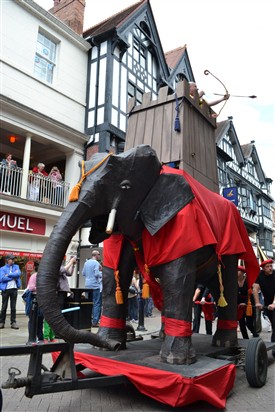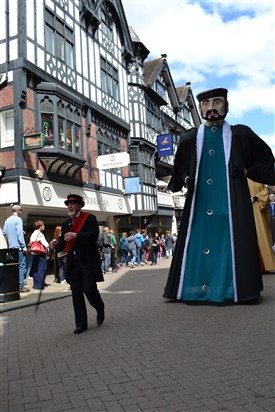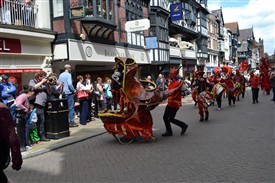Midsummer Watch parade in Nottinghamshire

The Chester Midsummer Parade is famous for its elephant
RB Parish

The Chester Midsummer Parade is famous for giants
RB Parish

A typical feature a harrowing of hell
RB Parish
A June Custom
By R B Parish
Midsummer in many Medieval towns was signified by grand civic pageantry called the Midsummer Watch parade. In Nottingham, we have Deering (1751) to thank for a detailed record of the custom in the city noting:
“by an ancient custom, they keep yearly a general watch every Midsummer Eve at night, to which every inhabitant of any ability sets forth a man, as well voluntaries as those who are charged with arms, with such munitions as they have; some pikes, some muskets, calivers, or other guns, some partisans, holberts, and such as have armour send their servants in their armour. The number of these are yearly almost two hundred, who at sun-setting meet on the Row, the most open part of the town, where the Mayor's Serjeant at Mace gives them an oath, the tenor whereof followeth, in these words: 'They shall well and truly keep this town till to-morrow at the sun-rising; you shall come into no house without license or cause reasonable. Of all manner of casualties, of fire, of crying of children, you shall due warning make to the parties, as the case shall require. You shall due search make of all manner of affrays, bloudsheds, outcrys, and all other things that be suspected, &c. Which done, they all march in orderly array through the principal parts of the town, and then they are sorted into several companies, and designed to several parts of the town, where they are to keep the watch until the sun dismiss them in the morning. In this business the fashion is for every watchman to wear a garland, made in the fashion of a crown imperial, bedeck'd with flowers of various kinds, some natural, some artificial, bought and kept for that purpose, as also ribbans, jewels, and, for the better garnishing whereof, the townsmen use the day before to ransack the gardens of all the gentlemen within six or seven miles about Nottingham, besides what the town itself affords them, their greatest ambition being to outdo one an- other in the bravery of their garlands. This custom is now quite left off. It used to be kept in this town even so lately as the reign of King Charles I.”
There are a number of references to this practice in Borough records. In 1557-9 12d was given to Damport for going about with his drum on St. John’s Night and St. Peter’s before the watch and 16d for “for 2 gallandes wyn that ye wach had on Mydsomer nyght” and another 8d in 1529-30 for a ‘pottye of Malse that was dronke at the crosse on Cobcryste Day.’
The reason for such a ceremony may seem a little confused. Midsummer had been celebrated since pagan times, the feast of St John being welded to it in the Medieval period, but the watch appears to have been established at first to prevent rowdiness and trouble spilling out from the older traditional of midsummer fires. However, as it is clear here and elsewhere it soon absorbed some aspects of the celebrations it was controlling. Nottingham observances lasted longer than elsewhere where Protestant reformers suppressed.
As Chester revived its Midsummer Watch parade in 1989 to great success perhaps Nottingham could follow suit.